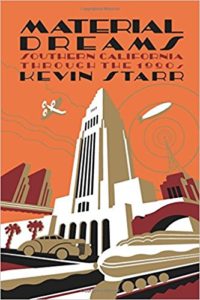[contextly_auto_sidebar]
LIKE a lot of people, I was originally baffled when I moved to California, which in my case was 20 years ago, this July. Some of the key to its complex code arrived in the books of historian Kevin Starr, which begin with statehood and move epoch-by-epoch to the early post-World War II years.
Today I have a sort of appreciation of the man, who I regret to say I met only once. (He was entirely gracious/ humble, and greeted me as “a fellow toiler in the vineyards of California history,” which I did not quite deserve.)
“He saw the state as one giant narrative,” Gustavo Arellano, the OC Weekly editor known for his Ask a Mexican column, told me. “So much California writing takes only one piece.” Part of the reason this expansive style has fallen out of fashion, Arellano says, is because much scholarly history over the last few decades has been dedicated to overlooked subaltern groups — peasant women, racial and ethnic minorities, working-class men — or specific forgotten figures.
“Starr was an old-school historian, who came up before Chicano Studies,” Arellano said. “He was smart enough to know he had to tell those stories too.” Arellano has been reading Starr’s work since he was a college student, and continues to rely on it as a reference for his journalism, including his regular pieces on OC’s racist and right-wing roots.
One of the puzzles of Starr’s long and productive career was his inability to write a book on the period of his adult life — the ’60s, ’70s, and ’80s — which were fascinating and important years for California.
“I wish I knew the answer,” historian William Deverell of USC and the Huntington says of the three-decade gap. “That period demands a kind of Kevin Starr capaciousness. We will miss that book — it may have been too personal.” Indeed, Starr told my wife, when she interviewed him on his imperfect ’90s volume, Coast of Dreams, that he had trouble making sense of that era, especially its darker themes, no matter how hard he tried.
Starr was born in 1940, but there was something old-school about him from the start. Says Deverell: “Kevin was the kind of guy who, when he got a cane, everyone was like, ‘Yes — he’s someone who should have a cane.’ ”
One thing sometimes overlooked about Starr, in part because of his Ivy League style and his affinities with the era of his grandparents, is that he was a great lover of music, from collegiate fight songs to rock n roll.
“The early ‘60s Beach Boys were bringing California to the world,” Deverell says of one of Starr’s favorite groups. “Kevin did that too.”
The list of historians who’ve really shifted the way we see a region or era is not terribly long. W.E.B. DuBois remade our understanding of Reconstruction, racism and capitalism in the first decade of the 20th century, C. Vann Woodward destroyed Southern nostalgia in a series of essays on the burden of the region’s history, Gordon Wood revealed the radicalism of an American revolution known popularly through three-cornered hats, and Eric Hobsbawn reframed “the long 19th century” around class conflict and imperialism.
 Was Starr able to do the same for California?
Was Starr able to do the same for California?
In any case, here is my piece for Zocalo Public Square.

I studied with Kevin Starr at Harvard in the early 70s. Though we shared little in terms of background, we did understand being there and having roots in other regions of the country (I was from Texas), an interest in history, and a desire to fit that interest into a larger world. Kevin was the kind of professor who sent me with his blessings on a chase across Texas, taking photographs of places connected to Texas folk stories. He understood the need to get into the field, in spite of the seeming formality of his own approaches to big topics.